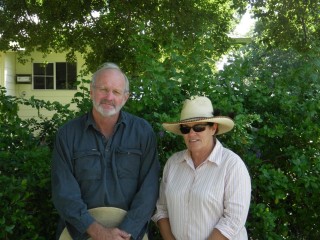A $25,000 investment in a telemetry system to remotely monitor watering points in a recently established cell grazing system has unlocked savings worth $14,500 a year for a Central Queensland grazing operation.
 Ross and Chris Rolfe are the owner-managers of a heifer backgrounding business spread across three properties south of Springsure in central Queensland.
Ross and Chris Rolfe are the owner-managers of a heifer backgrounding business spread across three properties south of Springsure in central Queensland.
Birrong (1225ha) is the home block, and was passed on from Ross’ parents, who acquired the block in 1966. Derillo (1012ha) was bought by Ross and Chris and is situated approximately 50km from Birrong. Kelvin Downs (2833 ha) is a lease block located between the two other blocks.
Birrong and approximately two thirds of Derillo are developed for cell grazing, and Kelvin Downs and the rest of Derillo are run in a rotational grazing system.
The Rolfes run a backgrounding operation where they buy weaner heifers and sell them at 350kg. Recently the Rolfes have started trading culled cows. Their total number of cattle currently sits at around 2200 head, however this number varies with the season and the availability and price of cattle.
Originally the Rolfes primarily farmed Birrong, however, due to a number of reasons, including the cost of new technology and equipment, it was decided to phase out their farming activities and go entirely into grazing.
With the decision to stop farming and go into cell grazing, the Rolfes had to redevelop their country, adding a large amount of infrastructure. This included the redevelopment of an old bore and the drilling of a second one.
Along with the bore on Derillo, they placed Sun-Sub solar pumps on all the bores and used pressure sensors to control the bores.
However they were not completely satisfied with this system and researched some alternatives. One option was to remotely monitor the water system using telemetry technology. After some investigation, a telemetry company, Observant, was consulted. It came up with a water management solution that was specifically designed to suit the Rolfe’s needs and incorporated the Sun-Sub solar system.
The decision to implement telemetry technology was made very simple by the approval of a one-off State Government funding application, which covered the full initial set-up cost of the Observant equipment.
In March 2006 the technology was put in place. The system includes a level sensor and flow meter on all the bores and storage tanks.
A real-time reading of these sensors can be accessed on a computer at the Birrong house.
The bore pumps run automatically, switching on and off according to the level sensors. However the pumps can also be switched off and off manually from the computer at the house.
This system uses a UHF signal to relay the information from the units to the home computer.
Ross and Chris estimate the initial set-up costs of the equipment to be approximately $25,000 and after doing conservative sums believe that removing one water run per week saves $14,500 per year.
The Rolfes saw the implementation of the remote water monitoring technology as an ideal opportunity to introduce a water medication system.
With relatively accurate water consumption per livestock unit (LSU) information, they can accurately supplement their cattle, reducing costs and risk.
They use a mobile medicator that attaches to the pipeline approximately 50m from the trough. They find having a mobile system close to the trough means they can quickly remove the urea from the watering system if a problem arises.
As with any technology there have been some problems, including the need to replace four level sensors and a software change in the Sun-Sub solar system that caused it to not respond to the Observant units. However, the problems were easily fixed and Observant currently offer reliable, free-of-charge technical support.
The Rolfe’s advice to other producers:
- Don’t buy a system just because you have been told it is good. Do the sums and decide if it is going to be the right decision for you.
- There is a certain level of technology involved, so if you don’t feel comfortable dealing with it then it’s not worth it.
- If you are going to set it up, make sure it is done correctly either by yourself or by a professional.
Not only do Ross and Chris run a successful grazing business, they are, and have always been, heavily involved in the local community, While their children were still at school Chris was involved with the P&C and sporting groups including Pony Club and the local football club. She is also on the committee for the local aged care. Both she and Ross are involved in the gun club, campdraft society and cutting. Ross is also a councillor on the local shire council, and Chris is the vice-president and treasurer for Queensland State Farm Organisation AgForce.
This article reprinted from the December 2011 edition of the CQ Beef Newsletter with kind permission from the Queensland Department of Employment, Economic Development and Innovation
